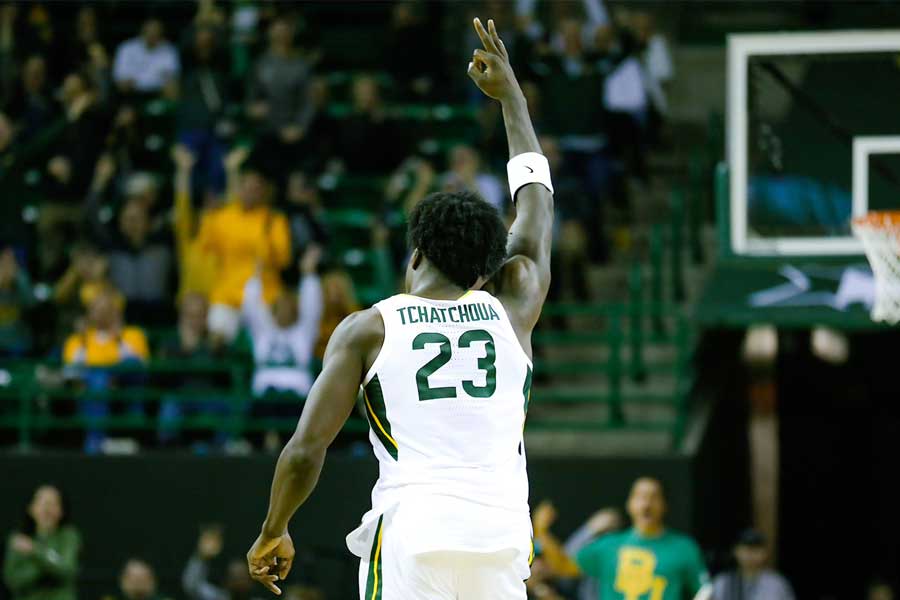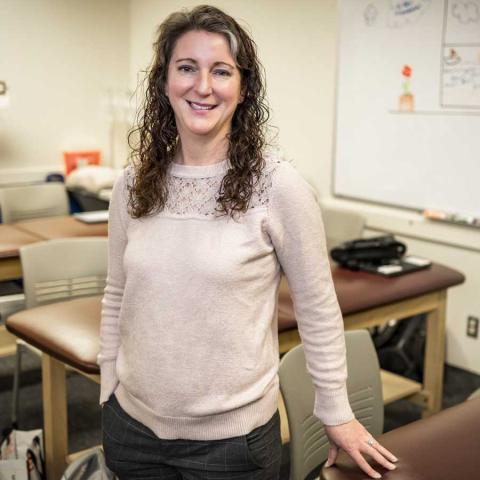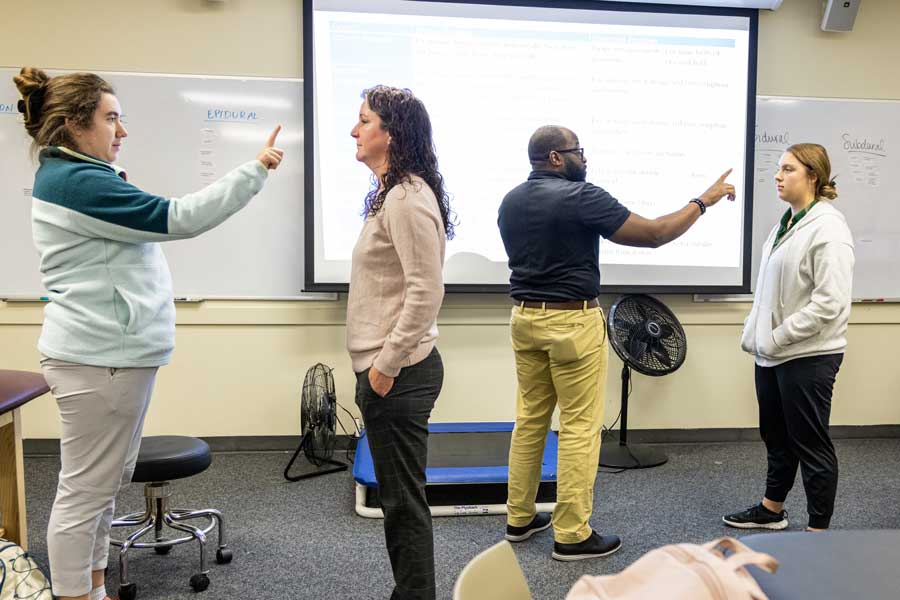Beyond the Game
As the public has continued to learn the value of athletic trainers, Baylor is employing and producing some of the best in the industry
When the Cincinnati Bengals hosted the Buffalo Bills for an NFL Monday Night Football game Jan. 2, 2023, millions of viewers in the national television audience tuned in to a game with significant ramifications for playoff matchups as the league approached the final weeks of its regular season.
Early in the first quarter, Bengals wide receiver Tee Higgins caught a pass over the middle from quarterback Joe Burrow, meeting Buffalo safety Damar Hamlin just beyond the 50-yard line, with Hamlin wrapping up Higgins for a routine and otherwise unremarkable tackle.
The scrum of players in and around the tackle picked themselves up from the grass and began moving on to the next play — all except Hamlin who stood up briefly before collapsing backward and motionless on the field.
Hamlin experienced cardiac arrest with his survival widely credited to the rapid response of medical personnel administering nearly 10 minutes of CPR resuscitation and defibrillation, including Buffalo’s assistant athletic trainer Denny Kellington, credited by Bills head coach Sean McDermott for “saving Damar’s life.” As one of the team’s athletic trainers, Kellington was the first on the scene.
The days following the collective trauma of the events of that Monday evening were filled with promising news for Hamlin’s eventual recovery and a newfound awareness of the crucial — and in this case, life-saving — service that athletic trainers provide for communities, teams, organizations and businesses throughout the country.
Baylor benefits from both housing a world-class staff of athletic trainers within Baylor Athletics’ department of student-athlete health and wellness, as well as developing and training the next generations of athletic trainers through Robbins College of Health and Human Science’s athletic training program where students pursue a Master of Athletic Training (MAT) degree.
For Carrie Rubertino Shearer, Baylor’s associate athletic director of athletic medicine, headline-grabbing crises like Hamlin’s give her and her team of athletic trainers that serve the student-athletes in Baylor Athletics time to pause and consider their own preparedness if faced with a tragedy of similar proportions.
“We take a moment to look and make sure our emergency action plan (EAP) is in line with industry standards, ensuring that things like our automated external defibrillators (AED) are fully charged and operational and that they’ve been recently inspected,” Shearer said. “That was just an easy reminder to make sure that we reconvene for an emergency action planning meeting at the mid-year mark to do a rehearsal, being mindful of potentially new athletic training students or new coaches that might not have been there for our regularly scheduled meeting in the fall.”
To the average fan, the athletic training staff is likely indistinguishable from any other member of the coaching staff on the sidelines, with maybe the only difference being a gear bag at their side.
“They refer to the word trainer all the time, but they really are healthcare providers and, often, in a lot of places are an extension of the physician...”Carrie Rubertino Shearer
For the student-athletes that they serve, these athletic trainers are likely the individual on staff that they will spend the most time working with and communicating with throughout their time at Baylor — a duty that goes far beyond the misconception that athletic trainers are limited to taping ankles.
“They refer to the word trainer all the time, but they really are healthcare providers and, often, in a lot of places are an extension of the physician and become someone the physicians heavily rely on,” Shearer said. “It’s a partnership of giving information. There’s so much from the education side, the medical side, anatomy, straight up to emergency action planning.”
Baylor has taken a holistic approach to encourage the all-encompassing health and wellness of student-athletes, with significant investments made in strength and conditioning, medicine, nutrition, sports science, mental health and spiritual health, all with the hope of giving student-athletes the best opportunity to perform at the highest levels while mitigating injury.
“The ability to uniquely invest in the lives of our student-athletes is made possible by the standards we have set for collaborative care,” said Kenny Boyd, Baylor’s senior associate athletic director of student-athlete health and wellness. “Truly embracing a multi-disciplinary, patient-centered approach prioritizes the student-athlete care while they are at Baylor and prepares them to be champions in life after Baylor.”
Even so, injuries happen in sports at every level, with some of the greatest athletes in Baylor program history battling injuries to get back to form and back in a Baylor jersey. Robert Griffin III’s season-ending injury in his sophomore year could have kept him from winning the Heisman Trophy two years later. Lauren Cox was sidelined mid-way through the women’s basketball title game in 2019, only to bounce back for another All-America season in 2020. Jonathan Tchamwa Tchatchoua was questionable to walk normally again, let alone play basketball. His recovery and return to the men’s basketball team less than 12 months after his knee injury was celebrated around the country. Each of these student-athletes had to lean heavily on staff from every department, but particularly the athletic trainers to develop a plan to build back even stronger — a process that starts before the student-athletes get to campus.
“From the time they come in at physicals, we do a really thorough pre-participation history, evaluating what has happened in the past, what’s their family history like,” Shearer said. “We do one from a medical, nutrition and mental health standpoint that they fill out as soon as they get here. Those are all great precursors to how we can set up best-care strategies.”
These screenings before a student-athlete can even be cleared to officially “join” the team are potentially life-saving, checking for underlying conditions that could have gone otherwise undetected.
“No longer are we simply managing injuries sustained during athletic participation,” Boyd said. “Rather we are walking alongside our student-athletes to help them better understand how they should advocate for their own physical and mental health.”
At Baylor, this attention to detail is not only an opportunity to maximize the performance potential of each student-athlete, it also sets a higher standard that distinguishes the program from many of its peers in collegiate athletics.
Class to Practice
The advances in modern technology, medicine and sports science have reverberated throughout the athletic medicine industry, rippling out to include the evolution of academic programs that produce these first responders in athletic trainers.
Baylor’s Robbins College houses the athletic training program and the Master of Athletic Training (MAT) degree. This rigorous academic gauntlet is a professional athletic training program accredited by the Commission on Accreditation of Athletic Training Education (CAATE). Students graduating from the athletic training program (ATP) are eligible to sit for the Board of Certification exam and become a Certified Athletic Trainer (ATC). Students enrolled in the ATP gain first-hand learning experiences with Baylor’s athletics teams as well as other off-campus clinical sites.
“Their curriculum is difficult because of the hardcore accreditation standards that incorporate the profession’s performance domains, which are the guidelines for the type of care we are to provide for people,” said Heather Hudson, Ed.D., Baylor’s associate clinical professor and director of athletic training education. “Academic requirements, the in-class requirements for athletic training students, have become significant.”
Additionally, outside of the classroom, students are required to log clinical working hours, ranging from Waco Family Medicine and local high schools to professional sports organizations and industrial settings.
“What is unique about athletic training education is students are going into the clinics simultaneously while they’re in classes,” Hudson said. “Our students will be in class learning about something and then that afternoon, they’re at a clinical site and they’re working with their patients. They’re bringing what they’ve learned in class to life through real-time practice.”
For the Baylor MAT program, students are required to get 18 to 34 hours a week of clinical education and will typically log eight to nine placements over the course of their academic tenure. Undergraduate students at Baylor can enroll in a joint degree program that links the Health Science Studies (Pre-AT track) and MAT degree programs so students can receive two degrees in five years.
Team Care Teamwork
Hudson also chairs the Interprofessional Education Committee in Robbins College, a unique partnership across multiple departments and professions on Baylor’s campus that is finding dynamic ways to expose students to the team aspect of caring for patients.
“Our students have worked with Monique Marsh-Bell, Psy.D., associate athletic director for mental health services, and her team in Baylor Athletics to learn how to create actual mental health protocols around different types of injures, whether its concussion injuries or orthopedic injuries,” Hudson said. “They’re working to create policy while also having opportunities to work with the professionals to participate in completing an initial intake. Students gain perspective on how to care for someone from a holistic approach.”
Other partnerships from the MAT-IEP collaborations have included participating in a health fair with Baylor’s Louise Herrington School of Nursing students and working alongside Family Nurse Practitioner and Occupational Therapy students to develop strategies for providing culturally competent and interprofessional healthcare.
Holistic Practitioners
While many schools have quality MAT programs developing and equipping athletic trainers, Baylor’s program is set apart from its peers by a number of factors, not the least of which is the University’s commitment to combining spiritual formation alongside world-class academic pursuits.
“We’re trying to get individuals to understand spiritual care and how important that is as a part of holistic care for a patient,” Hudson said. “We want to help students develop their spirituality and we’re working through that alongside them. We try to teach our students to be holistic practitioners. They need the work in the classroom, they need the work in clinical, but they also need to understand how to discover new knowledge on their own, how to be able to read research to understand the newest innovations and how they could apply those in their clinical practice and what evidence supports them.”
You Want Us out There
Athletic trainers are living in and serving communities and organizations of all sizes, from professional sports teams in major cities to small rural school districts where the athletic trainer may be the first and only medical attention offered.
“If you need someone that’s going to advocate for your kid to make sure that their healthcare needs are taken care of, then you want an athletic trainer out on that sideline,” Hudson said. “You want us out there because the majority of us out there practicing are not worried about who wins or loses the game, or the money in it, or any of those things. We’re worried about making sure that the person that is out there — the student-athlete, the patient, the individual — is being taken care of at the highest level possible.
“Ninety-nine percent of the time, we’re not going to have a catastrophic injury. But that one percent that we do, you want us out there because we’re going to do what is needed. We’re trained differently than other health professionals — we are trained to be with individuals from start to finish. We’re with the population, in most settings, all of the time and because of that, we know them in a different way. We really invest in the people that we’re taking care of.”
From the NFL fields to the Amazon warehouses and from rural high schools to underserved health clinics, athletic trainers are providing vital healthcare and service to patients — and Baylor is sending and equipping the next generation of helpers to serve and care for communities throughout the country and around the world.
For more information about the Master of Athletic Training degree, visit robbins.baylor.edu/athletic-training.


